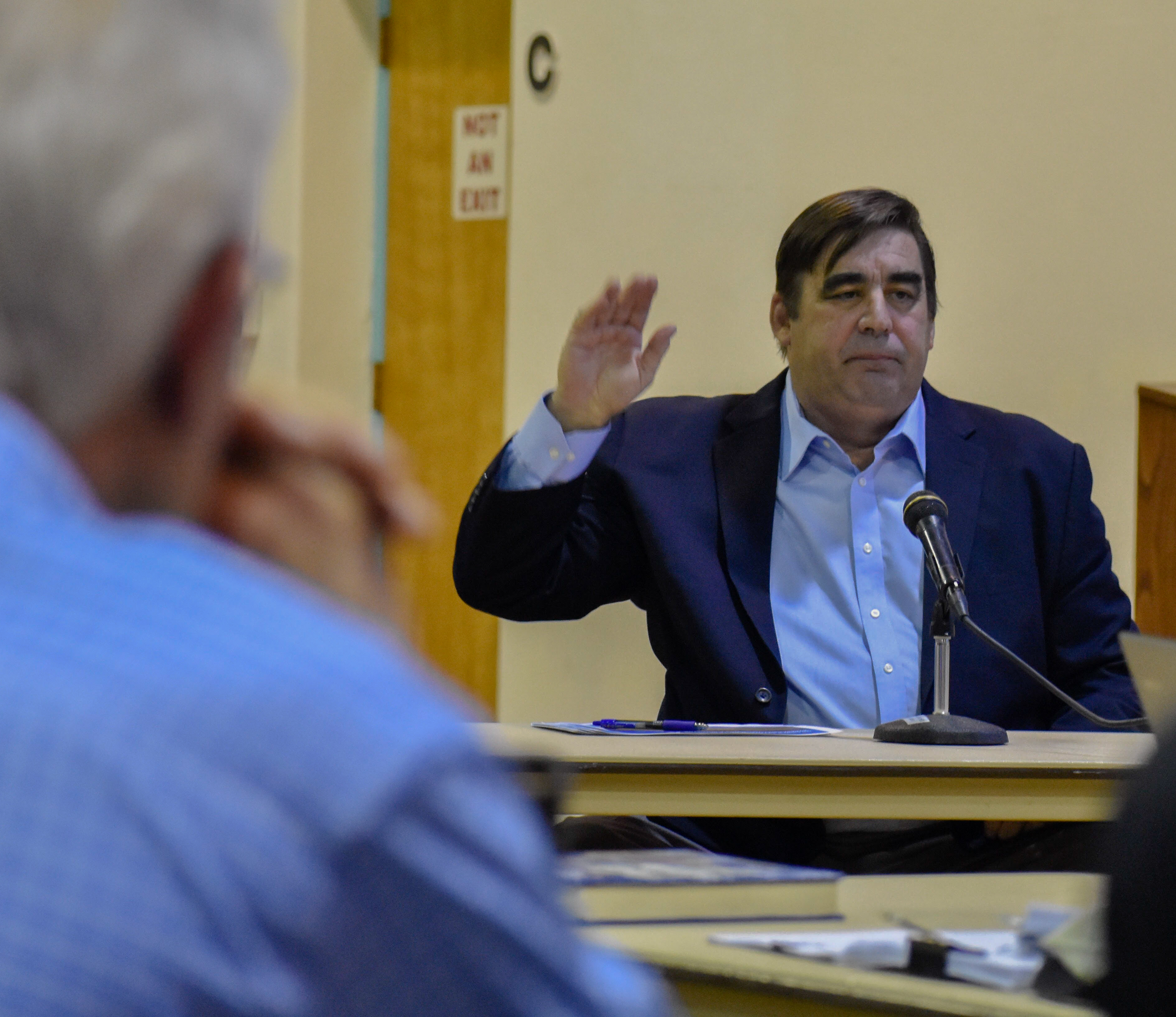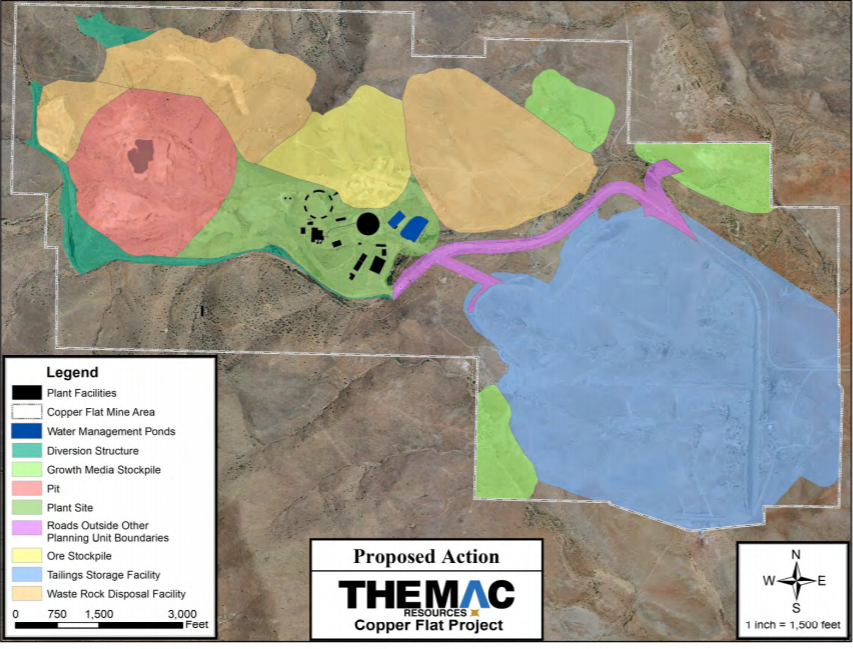Hillsboro, New Mexico has been known as a mining town since the late 1800’s. But, as time changes, so too have the sentiments of some of the town’s residents.
Rancher Bob Cunningham is a co-owner of the Hillsboro Pitchfork Ranch. His family bought the land in 1906.
“We’re both fourth generation owners, and we consider ourselves the caretaker of our family ranch and our family heritage,” Cunningham said.
Cunningham lives seven miles from an idle mining facility known as the Copper Flats Mine. He said his ranch will be negatively affected if the mine resumes its activities.
Copper Flats is an open pit mine that was active for a few months in 1982, until copper prices dropped from $1.70 to $0.70 a lb. Afterward the mine was sold, and another company re-established operations in 1994, until that company went bankrupt in 1999.
For the past eight years, the New Mexico Copper Corporation (NMCC) — a subsidiary of a Canadian mining company known as THEMAC Resources Group — has been obtaining permits to reopen the mine while investing more than $55 million in its reboot.
Cunningham has been growing more concerned as the mine’s reopening has progressed.
He was one of more than two dozen people who attended a hearing Monday, Sept. 24, in Truth or Consequences, New Mexico.

The hearing, organized by the New Mexico Environmental Department, focused on THEMAC Resources Group’s pursuit of a groundwater discharge permit. The company needs this permit to discharge liquid waste created from mining. The groundwater discharge permit is one of the two last permits needed to begin operations.
Jeffrey Smith, the chief operating officer for THEMAC, said the company has spent years “scrutinizing the mining plan and the history of the site.”
“There are many issues connected with the operation of this mine, but we’re here this week to discuss only one important subset of issues — potential impacts to groundwater quality and the measures to be taken to prevent those impacts,” Smith said.
According to a 2015 Environmental Impact Statement (EIS) produced by the U. S. Bureau of Land Management (BLM), the mine will consist of the following:
- An open pit
- This is where materials will be extracted for the life of the mine, 11 years. The EIS claims the mining process will extract about 6.4 million tons of copper ore per year along with gold, silver and molybdenum. Instead of tunneling through the earth, a quarry will be used for extraction.
- According to the EIS, a 5.2 acre lake is located in the existing pit. To mine the area, water would be continuously pumped out throughout the mine’s life.
- A crushing facility
- After materials are extracted from the earth they will be crushed into smaller pieces.
- A floatation mill
- Minerals will be extracted via a floatation mill. Dense liquid chemicals, heavier than copper, will help separate copper ore as it floats to the surface or near the surface for extraction.
- A lined tailings storage facility
- This is where mine waste will be stored. The tailings storage facility consists of a 16.6 acre pond to hold the waste.
- The EIS estimates that the tailings facility will process 95 million tons of tailings–the leftover material after the desired mineral is extracted–throughout the life of the mine.
- A waste rock disposal facility
- This 260 acre area will hold waste rock for disposal.
- A low grade ore stockpile and ancillary facilities to support production.
The EIS states that the mine expects to use more than 22,000 acre feet of water per year — more than 7.1 billion gallons annually.

Cunningham said he opposes the mine for the effect the open pit will have on his uphill ranch.
“All of that water, particularly from our family’s property, is going to flow downhill into that pit and we have wells up-gradient that we use to water our livestock and that are critical to wildlife habitat in the area,” Cunningham said. “The dear, the elk, the bear — they all water in our watering facilities.”
The environmental study indicates groundwater will flow into the pit at a rate of 50 to 75 gallons per minute. The EIS estimates that it will take about a month to drain the pit. However, the water drained from the pit will be used in the mining process and maintaining mining infrastructure. Water for the mine will come from two sources, according to the EIS — process water and fresh water.
Process water, the EIS said, will be water collected during the operation from draining the pit, collecting stormwater and water that is coupled with copper ore.
Fresh water would be pumped from four off-site groundwater wells. About 28 percent of water used for mining will be supplied through fresh water.
The proposed mining action, according to the EIS, will result in significant environmental impacts 100 years after the mine closes.

Key among those impacts is the use of water — drawing from a large area.
“The Proposed Action, to process ore at a nominal throughput of 17,500 tons per day, is predicted to reduce groundwater discharge to Las Animas and Percha Creeks, Caballo Reservoir, and the Rio Grande below Caballo Dam, decreasing the amount of water available for surface water flow and plant evapotranspiration,” the 2015 EIS said.
To feed this need for water, in 2015, the mining company acquired a 15-year water lease from the Jicarilla Apache Nation for $50,000 a year. This water will not be used in mining, but to “offset” groundwater that is pumped from the pit. Per the agreement, the Jicarilla Apache Nation will release almost 1 billion gallons of water a year into the Rio Grande — this water is piped in from the San Juan River through the San Juan – Chama Project.
To sweeten the arrangement, THEMAC Resource Group agreed to “give preference in employment to members of the Nation and to maximize utilization of tribal members in all available employment opportunities.”
However, almost a billion gallons a year is not enough. It was reported that Smith said the Mine still needs 6,000 acre feet of water per year, which they will fight for in court.
While this solution may serve to offset the removal of groundwater flowing into the Rio Grande Basin, John Fleck, the director of Water Resources at the University of New Mexico, says there is a leak in the idea.
“We just have to recognize that that’s going to be a trade off — there’s going to be less water somewhere else,” Fleck said.
While the deal could lessen the mine’s impact on the Rio Grande, Fleck said groundwater will always flow toward the open pit.
New Mexicans are not the only ones that would be affected by the reopening of this mine.
On April 12, 2018, Pat Gordon, the Texas Rio Grande Compact Commissioner, sent an email to Tom Blaine, a New Mexico State Engineer, putting him “on notice of Texas’s concerns.”
“Texas is aware of NMCC’s attempts to acquire rights to water that would purportedly offset the impacts to the Rio Grande and Caballo Reservoir,” Gordon wrote. “The fifteen year lease that NMCC has with the Jicarilla Apache Nation for San Juan Chama Water, that New Mexico may require as some type of offset for the diversion of Texas’s Compact water, would not come close to remedying the immediate and long term depletions to the Rio Grande and Caballo Reservoir caused by the Mine.”
In other words, the mine’s water plan may undercut water treaties between New Mexico and Texas.
In 2013, Texas sued New Mexico, alleging that the Land of Enchantment is not giving the Lone Star State it’s fair share of water, per the 1938 Rio Grande Compact — a water treaty between Colorado, New Mexico and Texas. In January of 2018, the Supreme Court ruled that the federal government will now become involved in the water rights issue.
Fleck said while the Texas lawsuit looms, he expects the Office of the State of Engineer/Interstate Stream Commission to be protective of New Mexico’s water rights.
On Oct. 23 and 24, another public hearing will be held in Truth or Consequences concerning the mine operating permit for THEMAC Resource Group.
Anthony Jackson is a freelance reporter with New Mexico Newsport. He can be contacted on Twitter: @TonyAnjackson.